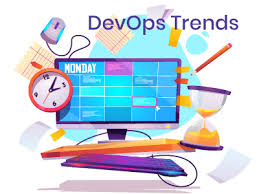
Have you heard IDC’s latest predictions on DevOps? According to this study, the DevOps market expects to grow from $2.9 billion to $8 billion by 2022! According to the experts, it is set to dominate the new decade by offering more excellent benefits to developers and users. Organizations are more likely to adopt DevOps at all levels now, as it is efficient and quick to implement. It is already starting to reshape the software world, and 2021 will undoubtedly be bigger and better than in previous years.
So what are the critical DevOps trends for 2021? We think these eight DevOps trends will steal the show now and shortly.

| The rise of AI
The time when manual testing will no longer be the order of the day is not far off. With AI combining with DevOps automation, the change in the way processes are performed is already underway.
AI uses logs and activity reports to predict the performance of a code. When you harness the power of AI, automating acceptance testing, implementation testing, and functional testing becomes easier for organizations. As a result, the software release process becomes flawless, more efficient, and faster, as continuous delivery is assured.
According to the latest expert predictions, there will be increasingly DevOps ideas in workflows due to the growing number of AI-powered applications. DevOps will emerge as the preferred option for managing the testing and maintenance of several models in the production chain.
| Using serverless computing in DevOps
DevOps is ready to reach a new level of excellence with serverless computing. These applications rely on third-party services, called BaaS (Backend as a Service), or on custom code running in temporary containers, called FaaS (Function as a Service).
Serverless means that the company or individual running the system does not need to rent or buy virtual machines to run the backend code.
The main advantage of serverless computing is that it gives the developer the freedom to focus solely on the development aspects of the application without having to worry about anything else. It does not require upgrading existing servers, and deployment is quick and easy. It also takes less time and doesn’t cost a cent.
| Controlling security breaches with DevSecOps
A majority of DevOps companies are turning to DevSecOps because the number of incidents related to security breaches has increased recently. IT companies consider DevSecOps as one of the many DevOps best practices.
Think of DevSecOps as an approach to application security that builds security into every aspect of the code from the beginning.
Security measures in the development process will lead to greater collaboration in the process. It will make the process much more efficient, error-free, and effective. Expect more adoption of DevSecOps in the years to come.
Save time through greater automation.
Detecting errors quickly, enhancing security, and saving time: automation offers all this and more. It eliminates the need for manual work throughout the software development cycle. It is no wonder that industrialization played an essential role in 2021.
So there are six Cs of DevOps, which are:
- Continuous optimization and feedback
- Continuous monitoring
- Continuous deployment and release
- Continuous testing
- Collaborative development
- Ongoing business plans
must integrate with each of these components in the coming years to be more efficient.
| The container of choice is Kubernetes.
Kubernetes has been a massive success in 2019, and this reign will continue in 2021 and beyond. Several valuable features and improved experiences have led developers to rely on Kubernetes more than others.
Kubernetes will help businesses in terms of scalability, portability, and automation, which is why it is considered one of the best container technologies. There will be new and better features of Kubernetes in the coming years that will support reliable and efficient distributed workloads in different environments.
| The growing popularity of Golang

Like Kubernetes, Docker, Helm, and Etcd, Google’s Golang is a programming tool that lends itself well to DevOps tools. It’s a new language compared to the other options, but it fits well with DevOps goals such as software and application portability, modularity, performance efficiency, and scalability.
Leading brands such as YouTube, Dropbox, Apple, Twitter, and Uber have adopted this cloud-based programming language.
With support from Google and ideal for DevOps, the future of Golang looks bright. DevOps teams have either already started using it or are planning to deploy it shortly. In the end, it will help organizations develop highly competitive concurrent applications with accurate results for software development companies.
| The growing importance of cloud-based native DevOps
It is possible to ensure better user experiences, better transformation, and innovation management when cloud-native DevOps is adopted. It is the proper use of technology to automatically manage the configuration, monitoring, and deployment of cloud services.
With cloud automation, the software can release faster. Thus, a bright future awaits cloud-based technologies. Oracle believes that 80 percent of enterprise workloads will eventually move to the cloud by 2025.
Moreover, the US Air Force has embraced cloud principles and has agile approaches to developing applications that run on more than one cloud format.
| Growth in the use of mesh services
Organizations can gain several benefits from adopting microservices. Developers use microservices to increase portability, even if it doesn’t make the DevOps team’s job any easier. Operators need to manage large multi-cloud and hybrid deployments.
The emergence of microservices has led to increased use of service networks, which promise to reduce deployment complexity. Service networks provide the ability to observe and manage a network of microservices and their interactions. This composition offers a complete view of services. It helps SRE and DevOps developers with their complex operational needs such as end-to-end authentication, access control, canary deployment, and A/B testing.
You’ll see an increase in adoption and offerings as these are critical components to running successful microservices. Service mesh is the crossroads that the enterprise must cross when moving from monoliths to microservices.
Conclusion
The DevOps field is constantly growing, and the future bodes well for it. Organizations all over the world are using it because of the many benefits it brings to their businesses. Keep a center on the most modern trends in such a situation because when DevOps reaches new heights, it will drag your business down with it. If you are looking for a software development team there are many software development companies that may help you in growing the buisness.
